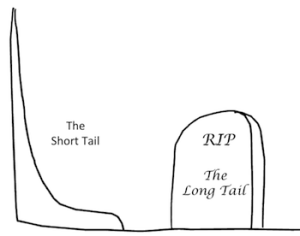The commercialization of the web and the proliferation of the mobile experience threaten to put the long tale of content to rest. Popular and paid content will outrank the obscure and unique.

To understand one has to look at the three ways that content is discovered:
Web Search – Algorithmic
Algorithmic is the Google way. The algorithms of search engines crawl the web, analyze and match user queries with publisher content, and serve ranked results.
Sophisticated machine learning algorithms analyze queries suggesting or re-writing them with the goal to guide users or providing instant answers. The unintended side effect is that users are funneled down the beaten path of popular (i.e. head) queries.
The commercial implication of search traffic has fostered link spam to a level, which threatens the search ecosystem. The last few Google search algorithm updates have been focused on penalizing sites that are deemed to have too many [monetized] pages and rewarding site freshness and authority for tail queries. Spam removal is good – the side effect however is that there is less incentive for publishers to produce and maintain content for tail queries.
Monetization of search is becoming more difficult because of increased competition for commerce-related queries and the disruptive effect of mobile in removing search as middleman. Google just introduced paid-inclusion for its shopping vertical and paid-placement with its Product Listing Ads, two strategies that are known to favor the head and starve off tail content.
Social Media – Crowdsourced
Social hasn’t reached the winner-takes-all state as web search yet. Using social activity – filtered by a user’s curated network of friends – to identify relevant content is however the Facebook way.
User submits, shares, comments, votes on content and Facebook through its algorithms determines what is popular for a given user and what is not. Popularity, defined by the number of content-related activities generated by ones network, does not favor tail content, i.e. the majority of people will not be heard.
Facebook recently overhauled its News Feed experience by changing the visual representation mainly by providing users more filters and by introducing larger thumbnails. Filters – if adopted by users – have the ability to create a larger surface for tail content. Larger images on the other side most likely favor head content.
The commercialization of the social stream has not reached the level of web search yet. The shift from desktop to mobile however has reached an infliction point and it can be only a matter of time until monetization pressure will change this too.
Mobile Local – Contextual
Mobile disintermediates web search. Users expect results relevant to their context and location. They are more likely to accept default results as answers rather than to search, analyze and refine. Such now-and-here decision-making naturally favors content in the head rather than tail.
Mobile apps are a convenient way of consuming content on a device, if they are readily available in the experience and have establishes a habit. This is a steep hill to clime for tail apps and an equivalent to navigational search queries – to easily locate and access content sources – hasn’t been established.
Location, images, videos and audio on mobile on the other side can open up a complete new way of identifying tail content by utilizing technologies such as bar code reading or facial/object recognition.
Mobile hasn’t produced a winner-takes-all service yet. Web search – by not indexing and surfacing user comments in blogs – has spawned social bookmarking sites and ultimately social networking – allowing user’s to share their [tail] content.
Mobile and social media favors the popular today. History indicates that we will see new and innovative services that allow people to express themselves on mobile.